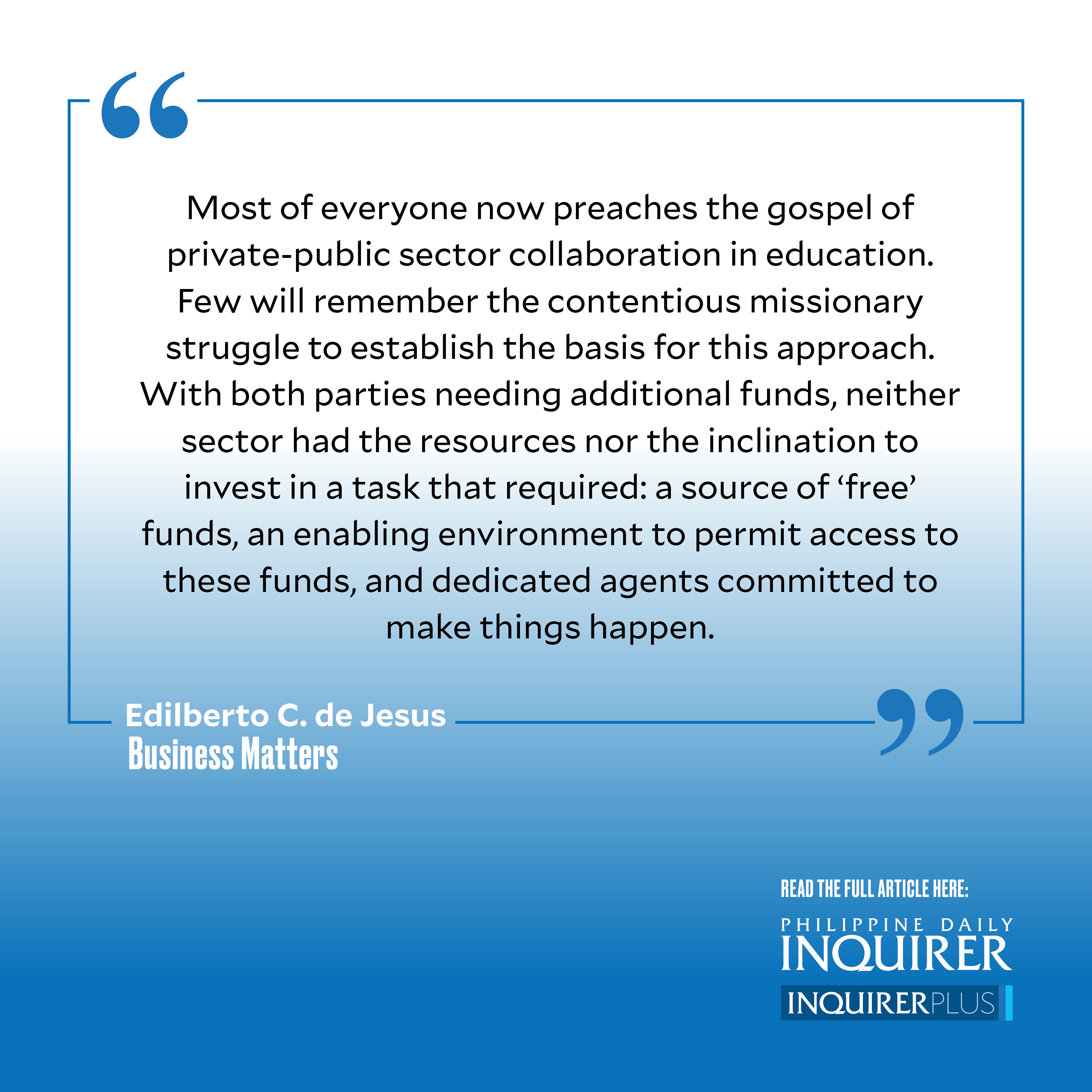Education competition-collaboration
Most of everyone now preaches the gospel of private-public sector collaboration in education. Few will remember the contentious missionary struggle to establish the basis for this approach. With both parties needing additional funds, neither sector had the resources or the inclination to invest in a task that required: a source of “free” funds, an enabling environment to permit access to these funds, and dedicated agents committed to make things happen.
Even fewer will recognize the three missionaries without whom, in the assessment of UP historian Bonifacio Salamanca, the Fund for Assistance to Private Education (FAPE) might never have been born. In his monograph on the founding and first decade of FAPE, Salamanca credits John W. McCarron, SJ, Thomas R. Fitzpatrick, SJ, and Pacifico Ortiz, SJ, with seeing the need for education collaboration, identifying the source of funds, and persuading decision-makers to deploy the funds for the purpose.
Article continues after this advertisementAll three were administrators of the Ateneo de Manila in the ’60s, deeply familiar with the problems of private education and committed to addressing them. McCarron and Ortiz saw an opportunity in the diplomatic discussions to negotiate the release of outstanding American World War II reparation funds then estimated at $73 million. They believed that private schools deserved a share of these funds in compensation for the devastation they suffered during the war. Obtaining American support for the plan became the object of McCarron’s private mission to the US in 1963 that he later continued as the representative of the Coordinating Council of Private Educational Associations (Cocopea).
The timing was propitious for a campaign to leverage personal and institutional links with high officials in the administration of the first Catholic American president. Ortiz worked to build support for the effort among Philippine educational associations and senior government officials. Fitzpatrick, treasurer of the Ateneo, developed options for the investment of the funds and the sharing of the proceeds among legitimate beneficiaries.
The US eventually agreed to release additional war damage funds. Concerned about potential government corruption, it welcomed the private sector campaign for a portion of the funds to support a special fund for education (SFE) in the US Treasury for academic exchange programs and other projects beneficial to both countries, as determined by their respective presidents.
Article continues after this advertisementFrom some $40 million that might be channeled to education, the private sector hoped to get half or at least $14 million to support three SFE programs: 1) improvement of teachers’ compensation and the provision of retirement benefits; 2) a low-interest, revolving loan fund for infrastructure development; 3) subsidy for faculty post-graduate degrees and research of faculty. But SFE still required the approval of the Philippine government, which sought, not surprisingly, to reserve the resources for its own projects or to exercise control over where they flowed.
Thus, President Diosdado Macapagal wanted the whole SFE dedicated to education for agrarian reform. But Macapagal, moving too slowly on the issue, lost his reelection bid to Ferdinand Marcos Sr. The Department of Education, under Carlos P. Romulo, pitched its own proposal for the SFE. It supported the idea of a soft loan fund for private school infrastructure development. But it wanted the Development Bank of the Philippines appointed as fund administrator and, essentially, to keep the government control over the funds. The two elements marginalized the role of Cocopea and the private sector in the SFE decision-making process and encountered determined opposition.
In the end, with the united front of the private sector and the support of American officials, Marcos Sr. yielded to the founding of FAPE in June 1968, with the Private Education Assistance Committee (PEAC) as its secretariat. But after all the backroom negotiations, FAPE ended up with only $6,154,000 of the $10 million it had hoped to receive. Meanwhile, through Secretary Romulo and Undersecretary Corpus, Imelda Marcos received $3.5 million to support the Philippine Cultural Center.
FAPE and PEAC have sustained for over 50 years the Government Assistance to Students and Teachers in Private Education, which allowed private schools to provide education to students the public schools could not accommodate. Expanding the scope for this kind of collaboration will require the same creativity, commitment, and courage invested in its creation.
——————
Edilberto C. de Jesus is professor emeritus at the Asian Institute of Management.
——————
Business Matters is a project of the Makati Business Club ([email protected]).
















